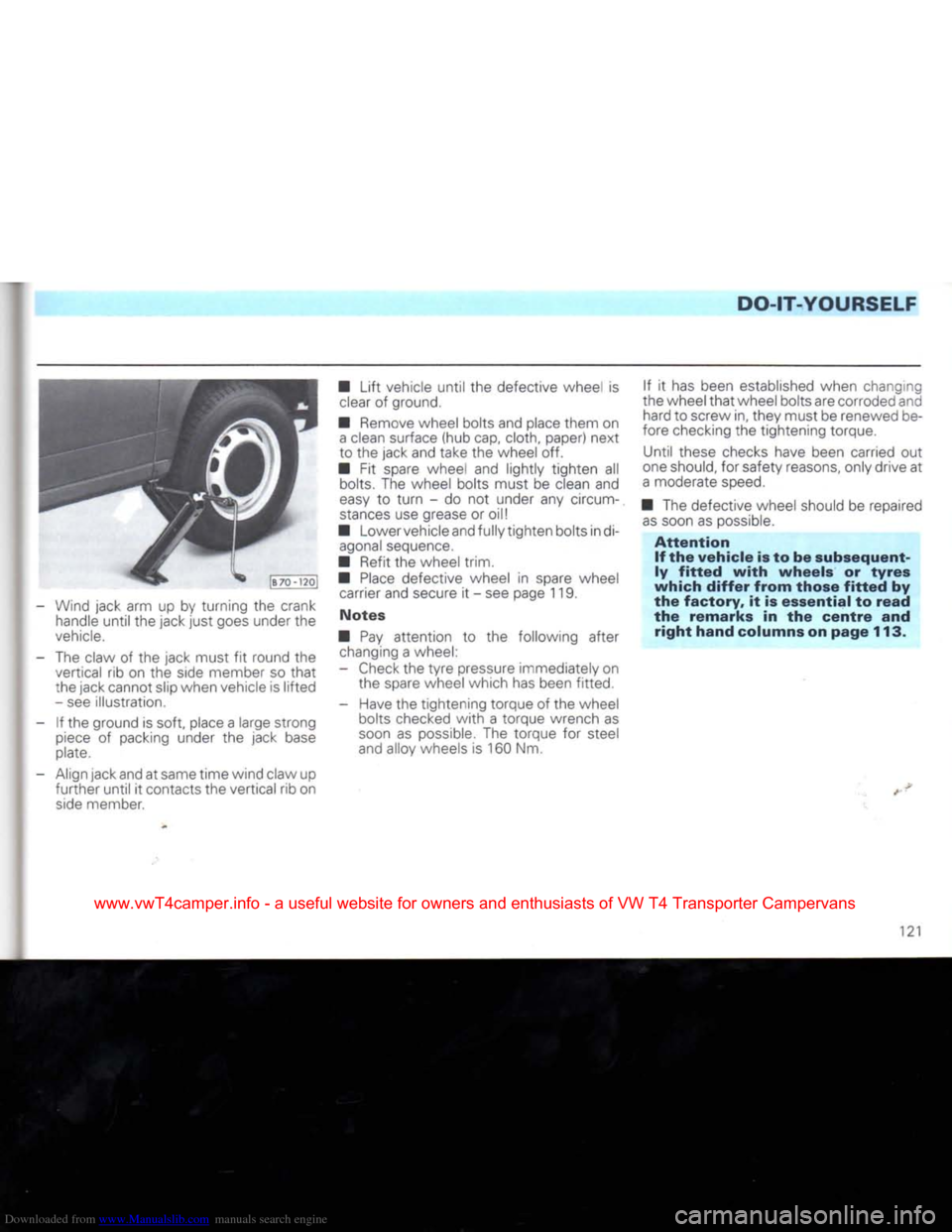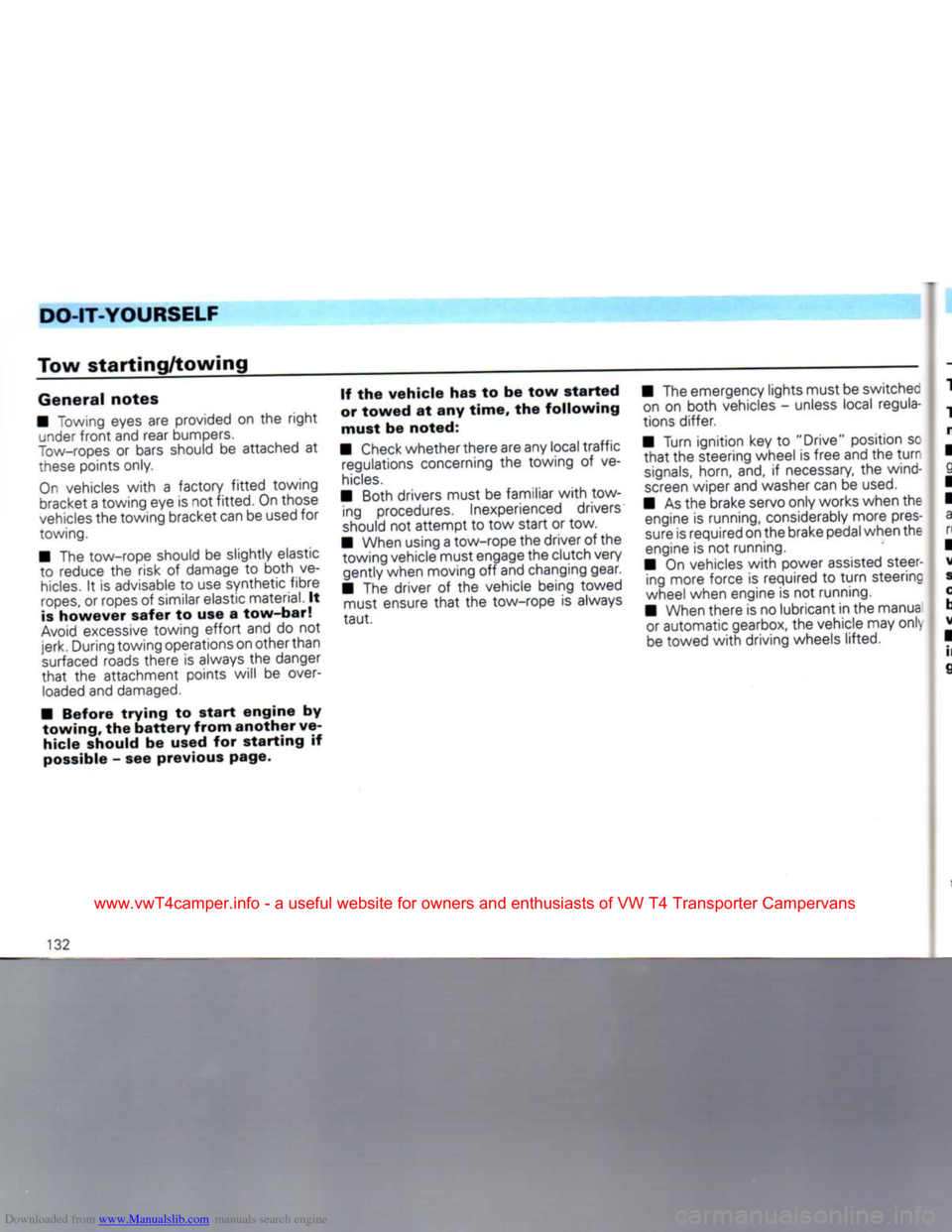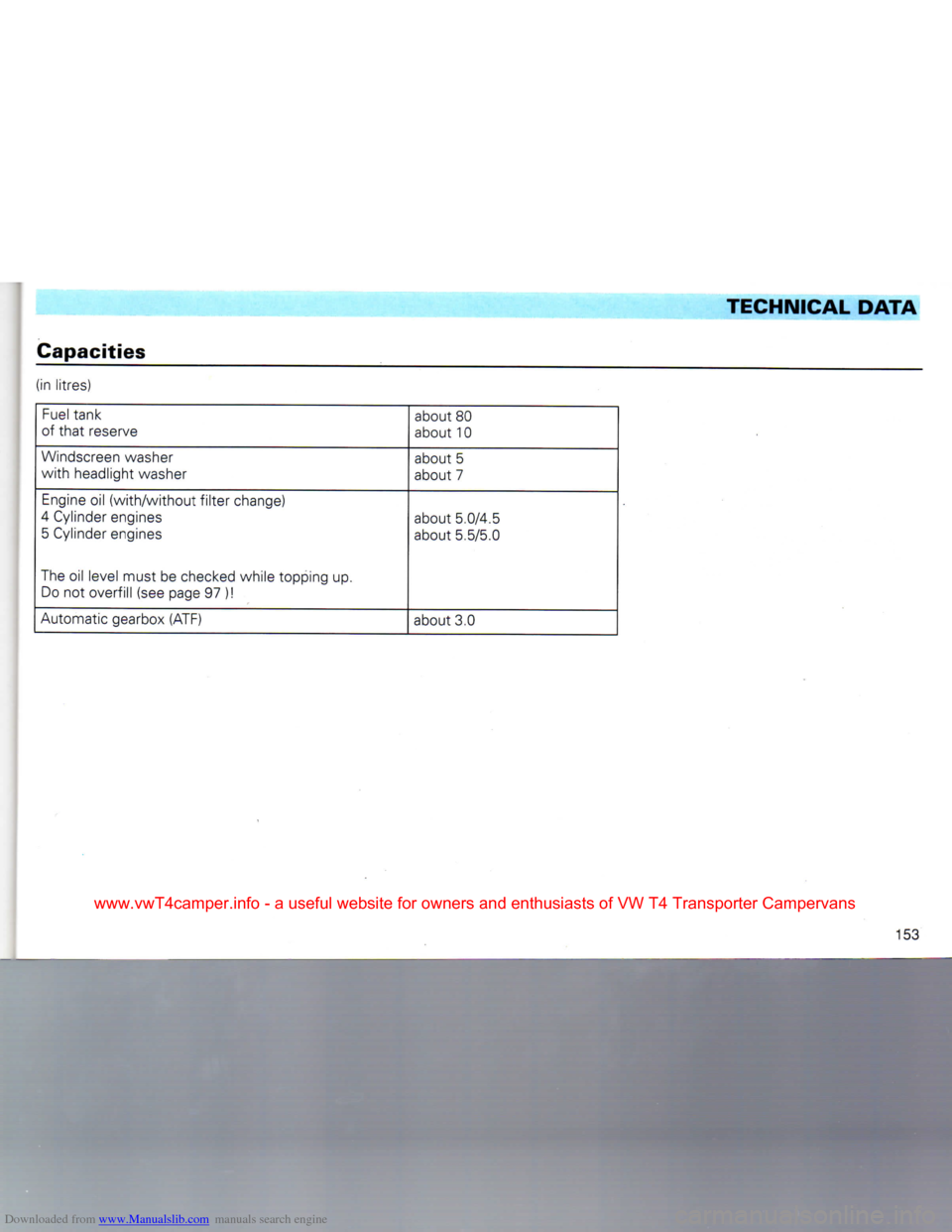1992 VOLKSWAGEN TRANSPORTER check engine light
[x] Cancel search: check engine lightPage 123 of 164

Downloaded from www.Manualslib.com manuals search engine
DO-IT-YOURSELF
- Wind jack arm up by turning the crank handle
until
the jack
just
goes under the
vehicle.
- The claw of the jack must fit round the vertical rib on the side member so
that
the jack cannot slip when vehicle is
lifted
- see illustration.
- If the ground is soft, place a large strong
piece
of packing under the jack base
plate.
- Align jack and at same time wind claw up
further
until
it contacts the vertical rib on
side
member. •
Lift
vehicle
until
the defective wheel is
clear
of ground.
• Remove wheel bolts and place them on
a
clean surface (hub cap, cloth, paper) next
to the jack and take the wheel off.
• Fit spare wheel and lightly tighten all bolts. The wheel bolts must be clean and
easy
to
turn
- do not under any circum
stances
use grease or oil!
• Lowervehicleand fully tighten bolts indi- agonal sequence.
• Refit the wheel trim.
•
Place
defective wheel in spare wheel carrier and secure it - see page 119.
Notes
• Pay attention to the following after changing a wheel:
- Check the
tyre
pressure immediately on the spare wheel which has been fitted.
- Have the tightening torque of the wheel bolts checked
with
a torque wrench as
soon
as possible. The torque for steel
and alloy wheels is 160 Nm. If it has been established when changing
the wheel
that
wheel bolts are corroded and hard to screw in, they must be renewed be
fore checking the tightening torque.
Until these checks have been carried out
one should, for safety reasons, only drive at
a
moderate
speed.
• The defective wheel should be repaired
as
soon as possible.
Attention
If the
vehicle
is to be
subsequent
ly
fitted
with
wheels
or
tyres
which
differ
from
those
fitted
by
the
factory,
it is
essential
to
read
the
remarks
in the
centre
and
right
hand
columns on
page
113.
121
www.vwT4camper.info - a useful website for owners and enthusiasts of VW T4 Transporter Campervans
Page 126 of 164

Downloaded from www.Manualslib.com manuals search engine
DO-IT-YOURSELF
Changing bulbs
Before
starting to replace a bulb, switch off
the light concerned.
Do
not touch the glass part of the new bulb
with
bare fingers because the finger marks
left
on the glass evaporate when the bulb
becomes
hot, the vapour settles on the re
flector and dims it.
Always
use the same type of bulb. The
des
ignation is marked on the base of the bulb
or on the
glass.
It is advisable to always a carry a box of
spare
bulbs in the vehicle. These can be ob
tained from Volkswagen dealers. It should contain at least the following bulbs which
are essential for traffic safety:
12 V 60/55 W Headlight (H4)
12V21W
Turn signal
12V21/5W
Brake
and tail light
12 V4W
Side
light
12V5W
Glass
base
Number
plate light
Headlights
The
headlight bulbs can be reached through
the opened bonnet.
• Pull off the connector.
• Pull cap off.
•
Squeeze
the spring clip of the bulb holder together and pull down.
• Take the bulb out and insert the new bulb
so
that
the locating lug on the bulb plate en
gages
the recess in the reflector. The centre
of the three terminals on the bulb base is
then at the top.
• Fold the spring clip over bulb
base.
Squeeze
the clip together and engage it in
the retaining lugs.
•
Press
the cap back on.
• Attach the connector.
• Have the headlight beam alignment
checked.
Side
light
bulb
The
side light bulbs are located in the head light reflectors.
• Turn the bulb holder fully to the
left
and take it out of the reflector.
•
Press
the defective bulb into the holder,
turn
it to
left
and take it out.
• Insert the new bulb.
• Insert the bulb holder in the reflector and
turn
the holder fully to the
right.
124
www.vwT4camper.info - a useful website for owners and enthusiasts of VW T4 Transporter Campervans
Page 127 of 164

Downloaded from www.Manualslib.com manuals search engine
DO-IT-YOURSELF
Front
turn
signals
To
change a bulb the
turn
signal housing must be taken out to the
front.
•
Insert
the
flat
blade of a screwdriver be tween headlight and
turn
signal
with
bonnet
open.
This presses the securing tabs which hold the
turn
signal housing to the
side.
• Swing screwdriver to
front
as shown in illustration so
that
the
turn
signal housing is
pressed
out forward. • Turn bulb holder out to the
left.
• Turn bulb out and renew.
•
Insert
bulb holder. •
Insert
turn
signal housing in the grooves provided (top and
bottom)
and press it in
until
the securing tabs engage.
Fog
lights*
The foglight bulbs can betaken out from un
derneath the bumper.
• Turn cap on rear of fog
light
to the
left
to remove it.
• Unhook spring clip of bulb holder and swing it away.
• Take bulb out.
•
Insert
new bulb so
that
the locating lug on bulb plate engages
recess
in the reflec
tor.
• Swing spring clip over bulb plate,
squeeze
it together and engage it in the re
taining lugs.
• Fit cap again.
• Have beam alignment
checked.
Rear
lights
Renewal
of the bulbs for the rear lights is
done from the luggage compartment
through the rear panel trim.
•
Reach
into
the hole in the rear panel
trim
with
one hand and squeeze the two retaining tabs of bulb carrier together.
• Take bulb carrier out (illustration). •
Press
defective bulb
into
holder slightly,
turn
it to the
left
and take it out.
•
Insert
new bulb and
turn
fully to the
right
• Install bulb carrier.
125
www.vwT4camper.info - a useful website for owners and enthusiasts of VW T4 Transporter Campervans
Page 134 of 164

Downloaded from www.Manualslib.com manuals search engine
DO-IT-YOURSELF
Tow
starting/towing
General
notes
• "owing eyes are provided on the
right
under
front
and rear bumpers.
Tow-ropes
or bars should be attached at
these
points only.
On
vehicles
with
a factory
fitted
towing bracket a towing eye is not fitted. On those
vehicles
the towing bracket can be used for
towing.
• The tow-rope should be slightly elastic to reduce the risk of damage to both ve
hicles.
It is advisable to use synthetic fibre
ropes,
or ropes of similar elastic material. It
is
however
safer
to use a
tow-bar!
Avoid
excessive towing
effort
and do not
jerk.
During towing operations on other than
surfaced
roads there is always the danger
that
the attachment points will be over
loaded
and damaged.
•
Before
trying
to
start
engine
by
towing,
the
battery
from
another
ve
hicle
should be used for
starting
if
possible - see previous page. If the
vehicle
has to be tow
started
or
towed
at any
time,
the
following
must
be noted:
•
Check
whether there are any local traffic regulations concerning the towing of ve
hicles.
• Both drivers must be familiar
with
tow ing procedures. Inexperienced drivers
should
not attempt to tow start or tow.
• When using a tow-rope the driver of the towing vehicle must engage the clutch very gently when moving off and changing gear.
• The driver of the vehicle being towed must ensure
that
the tow-rope is always
taut.
• The emergency lights must be switchec
on on both vehicles - unless local regula
tions differ.
• Turn ignition key to "Drive" position sc
that
the steering wheel is free and the
turr
signals,
horn, and, if necessary, the wind
screen
wiper and washer can be
used.
• As the brake servo only works when the engine is running, considerably more pres
sure
is required on the brake pedal when the
engine is not running.
• On vehicles
with
power assisted steer ing more force is required to
turn
steering
wheel when engine is not running.
• When there is no lubricant in the manua or automatic gearbox, the vehicle may only
be
towed
with
driving wheels lifted.
132
www.vwT4camper.info - a useful website for owners and enthusiasts of VW T4 Transporter Campervans
Page 155 of 164

Downloaded from www.Manualslib.com manuals search engine TECHNICAL DATA
Capacities
(in litres)
Fuel
tank
of
that
reserve about 80
about 10
Windscreen
washer
with
headlight washer about 5
about 7
Engine
oil
(with/without
filter
change)
4 Cylinder engines
5
Cylinder engines
The
oil level must be checked while topping up.
Do
not overfill (see page 97 )! about 5.0/4.5
about 5.5/5.0
Automatic
gearbox (ATF) about 3.0
www.vwT4camper.info - a useful website for owners and enthusiasts of VW T4 Transporter Campervans
Page 158 of 164

Downloaded from www.Manualslib.com manuals search engine
ALPHABETICAL
INDEX
A
Acceleration
figures 142
Accessories
117 Activated charcoal
filter
138
Additional heater 62
Additional water heater 67
Adjusting brake pressure regulator . . 155
Adjusting headlights 128 Adjusting washer
jets
108
Air
cleaner 100
Air
conditioner 57
Air
distribution 55
Alloy
wheels 91
Analog
clock 46
Anti-dazzle
inside mirror 13
Anti-freeze 101 Anti-locking brake system (ABS) .... 30
Arduous operating conditions 115
Armrests 21
Ashtrays
73
ATF
99
Automatic gearbox 32
Automatic wash plants 88
Auxiliary heater 63
Axle
loads 148
B
Battery 106
Belt height adjustment 16
Blower
55
Bonnet 94
Brake
fluid
104
Brake
servo 30
Brake
system 104
Brake
warning lamp 48
Brakes
29, 139
c
Capacities
153
Capacity
141
Care
of body 88
Care
of car 88
Catalyst
137
Cavity
preservation 92
Central
locking system 8
Cetane
Number 87
Changing
bulbs 124
Changing
front
turn
signal bulb 125
Changing
wheels 120
Chassis
number 154
Checks
when
filling
the
tank
160
Child
safety 18
Child
seats 18
Child-proof catch 9 Cigarette lighter 73
Cleaning
and anti-corrosion
treatment
of engine compartment 91
Clock
46
Cold
starting aid 38
Combined
weight 151
Compression
ratio
141
Consumption figures 143
Coolant
additive 101
Coolant
level 47, 102
Coolant
temperature - Gauge 41
Cooling
system 101
Cruise
control system 53
D
Dash
panel 4
Dashboard
and controls 4
Defrosting windows 56, 58
Diesel
fuel 87
Dimensions
152
Dip lever 52
Dipstick - Automatic gearbox 99
- Engine 97
Direction indicators 48
Do-it-yourself 118
Door
locks 9
Doors
9 Drawbar weight 83
Driver's seat 20
Driving abroad 115
Driving on holiday 115
Driving safely 78 Driving tips 76
E
Electric
socket 73
Electric
window
lifters
12
Emergency
lights 51
Emergency
starting 130
Emission
control system 137
56
www.vwT4camper.info - a useful website for owners and enthusiasts of VW T4 Transporter Campervans